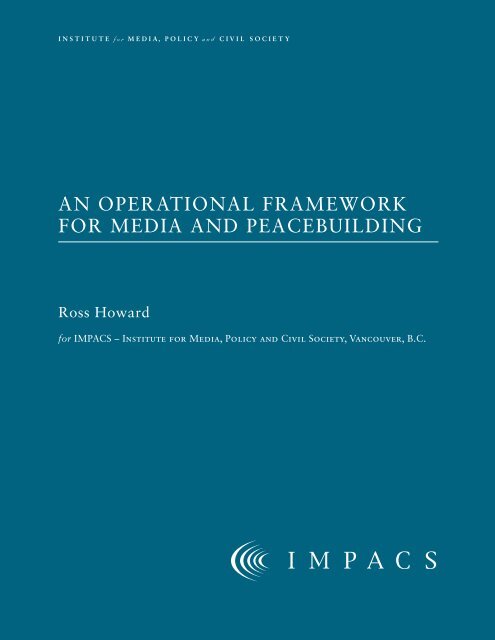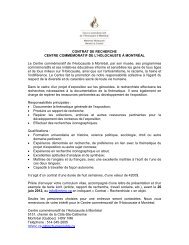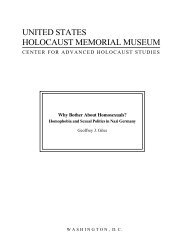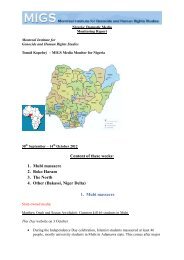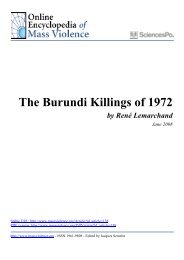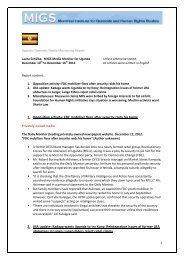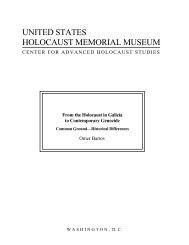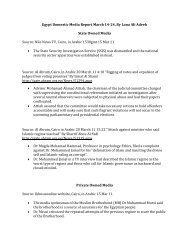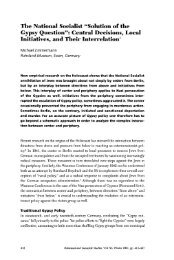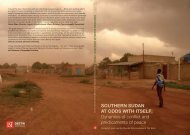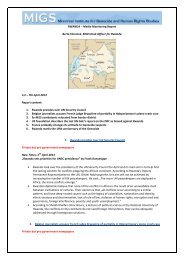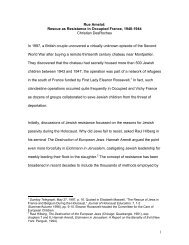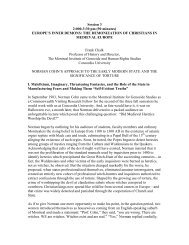An Operational Framework for Media and Peacebuilding - Montreal ...
An Operational Framework for Media and Peacebuilding - Montreal ...
An Operational Framework for Media and Peacebuilding - Montreal ...
You also want an ePaper? Increase the reach of your titles
YUMPU automatically turns print PDFs into web optimized ePapers that Google loves.
INSTITUTE <strong>for</strong> MEDIA, POLICY <strong>and</strong> CIVIL SOCIETYAN OPERATIONAL FRAMEWORKFOR MEDIA AND PEACEBUILDINGRoss Howard<strong>for</strong> IMPACS – Institute <strong>for</strong> <strong>Media</strong>, Policy <strong>and</strong> Civil Society, Vancouver, B.C.
INSTITUTE <strong>for</strong> MEDIA, POLICY <strong>and</strong> CIVIL SOCIETYAN OPERATIONAL FRAMEWORKFOR MEDIA AND PEACEBUILDINGRoss Howard<strong>for</strong> IMPACS – Institute <strong>for</strong> <strong>Media</strong>, Policy <strong>and</strong> Civil Society, Vancouver, B.C.JANUARY 2002
National Library of Canada Cataloguing in Publication DataHoward, Ross, 1946–<strong>An</strong> operational framework on media <strong>and</strong>peacebuilding1. Mass media <strong>and</strong> international relations.␣ 2. Mass media<strong>and</strong> war.␣ I. Institute <strong>for</strong> <strong>Media</strong>, Policy <strong>and</strong> Civil Society.␣II. Title.P96.I53H68 2002 070.4’49327172 C2002-910274-X© 2002 IMPACS – Institute <strong>for</strong> <strong>Media</strong>, Policy <strong>and</strong> Civil Society<strong>An</strong>y reproduction, modification, publication, transmission, transfer, sale,distribution, display or exploitation of this in<strong>for</strong>mation, in any <strong>for</strong>m or byany means, or its storage in a retrieval system, whether in whole or inpart, without the express written permission of the individual copyrightholder is prohibited.Published in Canada by IMPACS910–207 West Hastings StVancouver, BC V6B 1H6Tel (604) 682-1930Fax (604) 682-4353E-mail: media@impacs.orgWeb site: www.impacs.orgMarch, 2002Design <strong>and</strong> production by Alaris Design
ContentsAcknowledgements.................................................................................................................................................................. ivIntroduction .......................................................................................................................................................................................... 1The Context .............................................................................................................................................................................................. 2A Proviso .................................................................................................................................................................................................... 2Background ............................................................................................................................................................................................. 2What is the <strong>Media</strong>? ........................................................................................................................................................................ 4What is <strong>Peacebuilding</strong>? .............................................................................................................................................................. 5Cost Consideration ........................................................................................................................................................................ 5A Caution .................................................................................................................................................................................................. 5<strong>An</strong>alyzing the Conflict Environment ........................................................................................... 6looking at <strong>Media</strong> Interventions ................................................................................................................ 9A Typology of <strong>Media</strong> Interventions .............................................................................................. 10Key Considerations..............................................................................................................................................................12Lessons Learned .......................................................................................................................................................................... 20For Donors .......................................................................................................................................................................................... 20For Implementers ......................................................................................................................................................................... 20General Lessons .............................................................................................................................................................................. 21Appendix A: <strong>Media</strong> Initiatives ...................................................................................................................... 22Appendix B: Initiatives.................................................................................................................................................. 25Appendix C: Resources .................................................................................................................................................. 26
IntroductionThe media is a double-edged sword. It can be a frightful weaponof violence when it propagates messages of intolerance ordisin<strong>for</strong>mation that manipulate public sentiment. Radio MilleCollines in Rw<strong>and</strong>a is one of the most appalling contemporary examples.Using a blend of popular entertainment <strong>and</strong> proselytizing by announcers, thegovernment-supported broadcasts demonized one group of people <strong>and</strong> builtresentment <strong>and</strong> fear among the other group. The messages implanted <strong>and</strong>legitimized the belief that genocide was an appropriate self-defence initiative,<strong>and</strong> hundreds of thous<strong>and</strong>s of people were slaughtered in that country.But there is another aspect to the media. It can be an instrument ofconflict resolution, when the in<strong>for</strong>mation it presents is reliable, respectshuman rights, <strong>and</strong> represents diverse views. It’s the kind of media thatupholds accountability <strong>and</strong> exposes malfeasance. It’s the kind of mediathat enables a society to make well-in<strong>for</strong>med choices, which is the precursorof democratic governance. It is a media that reduces conflict <strong>and</strong> fostershuman security.This document identifies opportunities to strengthen the media as anelement of conflict reduction <strong>and</strong> peacebuilding. It is intended <strong>for</strong> donors,1
2 • AN OPERATIONAL FRAMEWORK FOR MEDIA AND PEACEBUILDINGagencies <strong>and</strong> nongovernmental organizations,media practitioners, governments <strong>and</strong>others, <strong>and</strong> conflict managers or peacekeepers.The fact is that media has becomeso pervasive <strong>and</strong> influential that anyonecurrently working in the field of conflictreduction must consider both edges of thesword. A project that launches withoutexamining the media environment, such asan indigenous media that is fomentinghatred, is more liable to fail. Similarly, anyef<strong>for</strong>t to resolve or prevent deadly conflictthat ignores the media as an opportunity initself is incomplete. This document offers aguide or framework <strong>for</strong> underst<strong>and</strong>ing howmedia-related interventions can be used in avariety of conflict conditions. The frameworkcan support planning, implementing orevaluating media initiatives to avoid risk <strong>and</strong>misapplication of resources.The framework provides some commonindicators or consequences <strong>for</strong> the media inenvironments of pre-, overt <strong>and</strong> post-conflict.It presents a typology of interventionspotentially appropriate to the media conditionsthat exist in those stages of conflict, orin others. It provides indicators <strong>for</strong> assessingthose interventions. <strong>An</strong>d the frameworkdraws operational lessons from mediarelatedprogramming <strong>and</strong> includes a matrixof exceptional examples of media peacebuildinginitiatives. A resources list is included.
The ContextJohn SylvesterA PROVISOThe material presented here can aid thinkingabout, <strong>and</strong> underst<strong>and</strong>ing of, media-relatedopportunities <strong>for</strong> peacebuilding. However,even the most rigorous framework is not atemplate <strong>for</strong> media initiatives. Every case ofmedia intervention is different. No mediapractice, nor any intervention strategy, islimited to a particular stage of conflict. Theuniqueness of every situation <strong>and</strong> the need<strong>for</strong> flexibility <strong>and</strong> innovation that respectslocal interests <strong>and</strong> skills cannot be overemphasized.Without committed localinterests, peacebuilding interventions arelikely to fail.<strong>An</strong>d it must be recognized that the media’sinfluence alone is insufficient to produce thechanges necessary <strong>for</strong> a society’s reconciliation,stability <strong>and</strong> security. <strong>Media</strong> initiativesmust work closely with other actors <strong>and</strong>initiatives, must be timed appropriately, <strong>and</strong>must demonstrate patience <strong>and</strong> longevity. Butequally, other initiatives such as emergencyrelief, democratic development, health <strong>and</strong>education can recognize that media initiativesfocused on conflict reduction inevitably benefitthem too. The potential <strong>for</strong> synergy is high.This framework is based upon a reviewof published sources, discussions withpractitioners in media <strong>and</strong> in peacebuilding,<strong>and</strong> interviews with, <strong>and</strong> contributions from,those working directly in the field. It shouldbe viewed as a work in progress – a learningtool that can be adapted as experiences <strong>and</strong>new ideas are brought <strong>for</strong>ward.BACKGROUNDThe significance of the media is obvious: itis often among the first elements of a societyto be disrupted in an overt conflict. Evenbe<strong>for</strong>eh<strong>and</strong>, parties seek control of the mediain order to influence news <strong>and</strong> opinions intheir own interests. The resultant harm hasbeen repeatedly documented. The massmedia played a central role in pre-war Nazimolding of German popular opinion againstJewish people. More recently in the <strong>for</strong>merYugoslavia, Serbian media revived newsreelsof decades-old conflict <strong>and</strong> atrocities as partof a campaign of propag<strong>and</strong>a <strong>and</strong> hate mongeringdisguised as news, to motivate popularsentiment against Albanians <strong>and</strong> others.Less well documented is the reverse ofmedia harm. A reliable, diverse <strong>and</strong> independentnews media has an almost innatepotential <strong>for</strong> contributing to conflict3
4 • AN OPERATIONAL FRAMEWORK FOR MEDIA AND PEACEBUILDINGresolution. It functions as a channel ofcommunication that counteracts misperceptions.It frames <strong>and</strong> analyzes the conflict,identifies the interests, defuses mistrust,provides safe emotional outlets, <strong>and</strong> more.As Robert Karl Manoff of New YorkUniversity’s Center <strong>for</strong> War, Peace <strong>and</strong> theNews <strong>Media</strong> points out, these are preciselysome of the elements that are involved in aconflict-resolution process.Some agencies <strong>and</strong> nongovernmentalorganizations interested in peacebuildinghave devoted ef<strong>for</strong>ts to encouraging areliable, diverse <strong>and</strong> free news media wherepossible in conflict-stressed environments.The most prevalent interventions havefocused on basic training <strong>for</strong> journalists, theprovision of technology <strong>and</strong> establishingbasic legal protections <strong>for</strong> journalists.Recently, new initiatives have focused onthe media as a means to communicatein<strong>for</strong>mation specifically intended to fosterpublic sentiment favouring peaceful resolutionof conflict. The focus is on the effect of themedia in its widest possibilities rather thanthe mere presence of professional news mediaoutlets. The media thus becomes a facilitatorof positive social change rather than aprofessional, disinterested observer/reporter.Under no circumstances, however, is thepromotion of biased in<strong>for</strong>mation or viewpointsmasquerading as journalism a validapproach.The examples of media <strong>and</strong> peacebuildingare growing but there is little documentation<strong>and</strong> analysis. <strong>An</strong>d the field is highly dynamic.The potential <strong>for</strong> synergy between thecommunication skills of journalism <strong>and</strong> theproactive people-centred approach of conflictresolution is particularly exciting. The finaldimensions of media <strong>and</strong> peacebuilding willnot be mapped soon. This framework aimsto strengthen peacebuilders’ capacity to morequickly grasp the existing possibilities, <strong>and</strong> toencourage exploration of entirely new ones.WHAT IS THE MEDIA?<strong>Media</strong> here refers to the several mediums orchannels used in an organized fashion tocommunicate to groups of people.Newspapers, radio <strong>and</strong> television are wellknownexamples. The Internet <strong>and</strong> WorldWide Web are more recent additions.However, <strong>for</strong> the purposes of peacebuilding,media encompasses more than just the news<strong>and</strong> in<strong>for</strong>mation business so typical of thosechannels. Entertainment programs frommusic to soap operas are part of the media.So are other channels including street theatre,posters, traditional story-telling, <strong>and</strong> evencomic books, to name only some.The news media, or journalism, remainsin the <strong>for</strong>efront of peacebuilding initiativesbecause at its best, it is the safeguard ofdemocratic governance. At its best meansaccurate <strong>and</strong> balanced reporting which fairlyrepresents a diversity of views sufficient <strong>for</strong>the public to make well-in<strong>for</strong>med choices. Areliable <strong>and</strong> diverse media that can expressitself freely provides early warning ofpotential outbreaks of conflict. It serves as awatchdog over leaders <strong>and</strong> officials <strong>and</strong> holdsthem accountable. It monitors human rights.Its presence is essential to the functioning ofother civil society actors. In less optimalenvironments, the media can still fosterstability by providing essential in<strong>for</strong>mationabout humanitarian initiatives.This framework explores in detail manyof the specific indicators by which mediafreedom, diversity <strong>and</strong> reliability can bemeasured, <strong>and</strong> offers strategies <strong>for</strong>responding. However, the key conditionsessential <strong>for</strong> a functioning free media can beboiled down to these: a state’s commitmentto Article 19 (the right to freedom ofexpression) of the Universal Declaration ofHuman Rights; a constitutional <strong>and</strong> legalinfrastructure to protect free expression <strong>and</strong>privacy rights; <strong>and</strong>, independent regulatorsof media rights <strong>and</strong> public responsibilities.
The Context • 5WHAT IS PEACEBUILDING?<strong>Peacebuilding</strong> means intensifying ef<strong>for</strong>ts toestablish lasting peace <strong>and</strong> to resolve conflictspeacefully in societies marked by conflict. Asthe Canadian Department of Foreign Affairs<strong>and</strong> the Canadian <strong>Peacebuilding</strong> CoordinatingCommittee have noted, in theirinsightful descriptions of peacebuilding, thefocus is on the political <strong>and</strong> socio-economiccontext of the conflict rather than themilitary or humanitarian aspects. Theoverarching goal of peacebuilding is toenhance the indigenous capacity of a societyto manage conflict without violence, as ameans to achieve human security. Always,however, external support <strong>for</strong> peacebuildingis an adjunct to local peacebuilding ef<strong>for</strong>ts<strong>and</strong> not a substitute <strong>for</strong> them.COST CONSIDERATIONS<strong>Media</strong>-oriented peacebuilding interventionsare cost-effective, compared to the cost ofconflict. Current technology can put an entiredigital broadcasting studio in a suitcase. Onelaser-guided bomb can cost equal the amountof an entire year of sophisticated programmingto encourage conflict resolutionin a war-torn society. However, mediainterventions require intensive advanceresearch, sensitization to local conditions <strong>and</strong>partners, <strong>and</strong> patience, which entails time<strong>and</strong> expense. <strong>An</strong>d experience has shown thatmedia projects must strive <strong>for</strong> longevityleading to sustainability to have lasting effect.Among the channels of communication,radio has the widest reach. Television can beexpensive but has a powerful effect uponthose who can receive it. The cost of otherchannels, such as newspapers or streettheatre or posters, varies widely. Their impactmay be a reflection of their innovative naturerather than their cost.A CAUTIONThe absence of a struggling media in acountry does not always mean there is animmediate opportunity <strong>for</strong> a media-relatedinitiative. Great caution <strong>and</strong> realism must beapplied to fully determine the controllingauthorities’ tolerance <strong>for</strong> an interventiondedicated to non-violent conflict resolution.<strong>An</strong>y state that suppresses a free media putsits commitment to justice, human rights <strong>and</strong>the rule of law very much in doubt. Prolongeddiplomacy, confidence building <strong>and</strong> tradeoffsmay be necessary to gain <strong>and</strong> maintainapproval <strong>for</strong> any media-related peacebuildinginitiative in such an environment.5
<strong>An</strong>alyzing the Conflict EnvironmentEvery conflict <strong>and</strong> peacebuilding situationis different <strong>and</strong> thus requires a specificexamination, especially today when mostconflicts are internal, not international. Mostconflict has complicated roots <strong>and</strong> there israrely a single determinant. Ethnicity,religion, economic or resource scarcity, <strong>for</strong>example, may be at play. A decision to considermedia-related initiatives needs to bein<strong>for</strong>med by a prior country <strong>and</strong> regionalconflict analysis. The analysis of conflict willinevitably produce indications of impactsupon media. For example, a pre-conflict climateof intolerance, human rights abuses <strong>and</strong>biased state authority may be reflected insevere stereotyping, including gender typingin reporting, <strong>and</strong> in a self-censoring media.However, the media is more than a passiveindicator of conflict conditions, <strong>and</strong> theanalytical process should also seekopportunities <strong>for</strong> contributing to the media’spotential <strong>for</strong> positive influence in any conflictresolution process.Table 1 offers a number of indicators thatreflect some consequences of internal conflictupon the local or indigenous media in pre-,overt <strong>and</strong> post-conflict environments. Thetable reflects general experience, keeping inmind that all conflicts have uniquecharacteristics. Some conflicts do not fit anyone stage neatly. For example, long-term,low-intensity conflicts involving multipleactors can exhibit elements of all three stagesof conflict. Some warning signs overlap thesestages, as do the impacts on media. Otherconflicts, although internal by nature, haveinternational implications. These situationsinvite outside actors into the political arenafollowed by interested involvement byinternational media.6
<strong>An</strong>alyzing the Conflict Environment • 7TABLE 1. Stages of conflict <strong>and</strong> media impactsWarning SignsPre-conflictRising political tension, intensified central authority.Economic instability.Increasing economic or political disparity betweenidentity groups.Gender stereotyping intensifies.Weakening state <strong>and</strong> local authority.Increasing government corruption.Decline in civil society, rights infringements.Appearance of pro-peace/conflict prevention activists.Failing peace dialogue, negotiations.Abuse/distrust of electoral system.State or monopoly control of media outlets.Focused attack-journalism on opponents <strong>and</strong> moderates,signaling emergence of hate speech.Overt conflictOpen conflict: military attacks, killings, atrocities.Suspension of civil rights, associations.Widespread human rights abuse/atrocities.Collapse of civil society.Denial, disavowal of international covenants.Forced mobilization/conscription.Forced migration, displacement.Infrastructure destruction: material shortages, food,water, fuel, health care, electricity, batteries.Destruction of education system.Examples of Impacts on <strong>Media</strong>Increased media monopoly, censorship of journalism,suppression of external media sources.Decline in economic <strong>and</strong> editorial independence due toadvertising drop, cost increases. Poor remuneration ofjournalists causing widespread bribery. Decline ofprofessional st<strong>and</strong>ards.Polarization of media, identified with identity interests;reporting reflects exclusivity rather than inclusiveness.Stereotyping of others. Decline of diverse commentary.Harassment of non-con<strong>for</strong>ming journalists.Women displaced from media prominence <strong>and</strong> coverage<strong>and</strong> media staff positions.Reduced access to in<strong>for</strong>mation. Prejudiced regulation ofmedia. Bribery of journalists. Rise in crime reporting.Decline in investigative journalism. Equipment theft,damage, seizure.Absence of rights abuse reporting.Alternative, underground media take <strong>for</strong>m.Sensationalized coverage, focus on violence. Absence ofconsensus-seeking reports.Decline in coverage <strong>and</strong> analysis of politics.Emergence of partisanship disguised as newsgathering.State/monopolist imposition of compliant mediamanagers, journalists.Facile manipulation of popular sentiments. Propag<strong>and</strong>adisguised as news emerges.Take-over of media outlets, suppression of independentnews media.Journalists at personal risk in crossfire.Suppression of human rights monitoring-reporting.Hate speech emerges.<strong>Media</strong> rights abrogated. Journalists unprotected by laws.Suppression of media associations.Independent reporting termed unpatriotic.Displacement, shortage of experienced media workers,increase of inexperienced journalists. Lack of diversityof reporters, sources.Loss of equipment, supplies, blocked travel, access tosources. Inability to report, distribute, broadcast.Inability of audience to receive media.Absence of training, professionalization. Decline ofliteracy, decline in readership of print media.
Looking at <strong>Media</strong> InterventionsJohn SylvesterThe traditional focus of media-relatedinitiatives has been on conventionaljournalism that supports the emergenceof good governance <strong>and</strong> democraticdevelopment, particularly in post-conflictenvironments. The focus is logical, sincetraditional journalism’s calling is to presentfacts <strong>and</strong> viewpoints that enable citizens tomake sense of their world <strong>and</strong> exercisechoices in their best interests.The newer category of media-relatedpeacebuilding goes beyond the traditionaldisengaged journalistic role. It is designed tohave an intended outcome: a reduction ofconflict among citizens. Rather than merelyin<strong>for</strong>ming, material is selected <strong>for</strong> itspotential in trans<strong>for</strong>ming conflict, by shiftingattitudes of the parties involved in conflict,by providing essential in<strong>for</strong>mation. Thisapproach also extends from traditionaljournalism media into avenues such aspopular music, soap operas <strong>and</strong> call-inshows, community radio <strong>and</strong> video projects,<strong>and</strong> street theatre, wall posters, or concerts.It can be highly effective, particularly inconflict-ridden areas where audiences aredesperately receptive to in<strong>for</strong>mationpresented in an entertaining <strong>for</strong>m.Between these two categories lies a stageof media fusion. Journalists, mainly from theglobal northwest, have argued the ostensiblyimpartial role they play is incompatible withreporting which openly seeks conflictresolution or involves personal intervention.This position has discouraged synergisticrelationships among media practitioners <strong>and</strong>peacebuilders. However, especially in manymodern conflict environments, it isincreasingly obvious that the professionalnorms of journalism do not trump fundamentalmoral obligations.It is also clear that all journalistsunconsciously reflect personal <strong>and</strong> culturalvalues in selecting their content (or framingtheir stories, as it is called). What is neededis recognition of the value of framing stories<strong>for</strong> the benefit of conflict resolution. Withthis recognition emerges a journalism that issensitized to conflict resolution techniques,<strong>and</strong> seeks to maximize underst<strong>and</strong>ing of theunderlying causes <strong>and</strong> possible solutions. Insome conflict environments, journalists seetheir role as more complex than simplycarriers of in<strong>for</strong>mation, <strong>and</strong> they actively seekto facilitate the most important peacebuildingdialogues needed in their communities.9
A Typology of <strong>Media</strong> InterventionsJake LynchJust as specific impacts of conflict uponmedia are rarely unique to one stage ofconflict, media interventions also are notlimited to any one stage of conflict. Differentmedia interventions can overlap, operateside-by-side, or be combined depending uponcircumstances. Nonetheless, to establish acommon language <strong>for</strong> determining <strong>and</strong>comparing intervention opportunities, somepatterns can be identified <strong>and</strong> described.Five types of media intervention aredescribed here. Examples of specific peacebuildinginitiatives falling within the fivecategories are given later in this framework(Table Two).Type One. One common interventioninvolves initiatives to overcome journalismseverely constrained by its lack ofprofessionalism, diversity, freedom <strong>and</strong>technology. This rudimentary journalismtraining addresses unskilled, inaccurate,conflict-obsessed, or highly partisan media.Often this media is, or was, controlled bythe state or special interests <strong>and</strong> it reflectsnarrow views or propag<strong>and</strong>a. A legalframework regulating <strong>and</strong> protecting themedia is likely lacking. The <strong>for</strong>emost tool<strong>for</strong> peacebuilding here is training media inthe basics skills of journalism, such asimpartiality, accuracy <strong>and</strong> balance.Awareness of democratic practices, especiallyelection coverage, is essential. Technologytraining <strong>and</strong> equipment is also supplied; <strong>and</strong>,also included is the promotion of journalisticcodes <strong>and</strong> a basic legal infrastructure thatprotects journalists from intimidation.Type Two. A second type of mediaintervention provides more responsiblejournalism development beyond basic skills.Tools include developing investigative,explanatory <strong>and</strong> specialist reporting, <strong>and</strong>well-in<strong>for</strong>med analytical reporting. Initiativesinclude promoting <strong>and</strong> providing models <strong>for</strong>a full media infrastructure that includesimpartial regulators, media per<strong>for</strong>mancerequirements, access to in<strong>for</strong>mation, presscouncils, <strong>and</strong> promulgation of st<strong>and</strong>ards todefine libel <strong>and</strong> sl<strong>and</strong>er as elements of mediaaccountability. Developing diverse, competitive<strong>and</strong> sustainable media outlets, especiallythrough management training, is anothertool. The intention is to create a media thatserves society as a conflict resolution process<strong>and</strong> upholds democratic governance.Type Three. <strong>An</strong> emerging genre of mediaintervention is located between traditionaljournalism <strong>and</strong> more pro-active uses ofmedia. Journalists are encouraged toconsciously examine their role to recognize10
A Typology of <strong>Media</strong> Interventions • 11conflict resolution as part of that role. In thistransitional journalism development,journalists <strong>and</strong> media managers redefinewhom <strong>and</strong> what is newsworthy, to betterin<strong>for</strong>m <strong>and</strong> encourage reconciliation.Sensitized media professionals may see theirrole as more than observers <strong>and</strong> carriers ofin<strong>for</strong>mation <strong>and</strong> may seek to facilitate criticaldialogues within the community. Someprofessionals <strong>and</strong> theorists aptly call this typeof intervention peace journalism, reflectingthe dual nature of their work as journalistswith conflict resolution as one of theirrecognized values. Other sources ofjournalism media such as underground radiostations may be involved, often in hostileenvironments.Type Four. Distinct from conventionaljournalism is pro-active media-basedintervention, usually designed <strong>for</strong> a highlyspecific audience <strong>and</strong> purpose. It is often theproduct of an outside intervenor such as apeacekeeping <strong>for</strong>ce or a nongovernmentalorganization <strong>and</strong> is often deployed in aconflict or post-conflict environment. It canbe media intended to counter hatepropag<strong>and</strong>a, or programming to provideimmediately practical in<strong>for</strong>mation such aselection <strong>and</strong> voting practices, refugeereunification, education or health advice.Type Five. Intended outcome programmingis specifically intent upon trans<strong>for</strong>mingattitudes, promoting reconciliation <strong>and</strong>reducing conflict. It is not conventionaljournalism. It is usually conducted bynongovernmental organizations. The contentis determined by its appropriateness tofostering peace. The programming <strong>and</strong>delivery mechanisms can be innovativeadaptations of a popular culture such asradio <strong>and</strong> television soap operas <strong>and</strong> dramas,street theatre, wall posters, <strong>and</strong> more. Theinitiative <strong>and</strong> programming may be closelyallied with other actors <strong>and</strong> projects. <strong>Media</strong>workers may play a role themselves asconciliators in the field.
Key ConsiderationsStages of conflict are often fluid withoverlapping characteristics <strong>and</strong> inconsistenttypes of media practices, whichchallenge easy prescription of the appropriatemedia-based peacebuilding initiative.Responding to the prevailing conflict stage<strong>and</strong> media environment will require carefulassessment of the conflict <strong>and</strong> any proposedintervention. Specific stages of conflict maybe open to, or require more than, one typeof media intervention.Appendices A <strong>and</strong> B each offer somespecific questions to be asked in conductingthese assessments. Underlying thosequestions are some general considerationsthat must be kept in mind:• Will the initiative affect individual orcollective abilities to identify <strong>and</strong>respond to conflict resolutionopportunities?• Will the project help or hinder relationshipsbetween the state <strong>and</strong> civil society?• Will it include members of thecommunities affected by the conflict?• How will the beneficial results be madesustainable?The engagement of the people mostaffected, which in a media initiative includesboth media practitioners <strong>and</strong> audiences, mustbe established. Their input, often overlookedor minimized, is crucial. Intended outcomemedia can be particularly successful atattracting audiences but sustained successrequires audience feedback <strong>and</strong> interactionthat, in turn, shapes the message.The progress <strong>and</strong> outcome of mediainitiatives will likely require great adaptability,<strong>and</strong> an acceptance of incrementalrates of change. It may be difficult to applyconventional measurements of an initiative’ssuccess as it directly relates to reducing <strong>and</strong>preventing violent conflict. In such a new <strong>and</strong>exp<strong>and</strong>ing field, conventional measurabilityshould be kept in perspective <strong>and</strong> not stifleinnovation or unique, local approaches.Table Two presents a typology describingmedia-related initiatives <strong>and</strong> indicators. Itdoes not exclude the overlapping ofindicators <strong>and</strong> strategies from one type toanother. It should not be applied restrictively.For example, a Type Five intended outcomemedia project can possibly be applied in anenvironment lacking several of the Type Fiveindictors such as audience rating capabilities,or even the basic conditions of Type Onerudimentary journalism.John Sylvester12
Key Considerations • 13TABLE 2. Interventions <strong>and</strong> Indicators<strong>Media</strong> Initiative Strategy IndicatorsType OneType TwoBasic training in st<strong>and</strong>ard ABC skills ofnewsgathering: accuracy, balance <strong>and</strong>context.Support <strong>for</strong> professional journalist associations,conduct codes. Partnership support<strong>for</strong> indigenous training facilities. Seminars,<strong>for</strong>ums <strong>for</strong> local journalists on professionalism.Support <strong>for</strong> independent media protection<strong>and</strong> regulation within legislation, regulations.Encouragement of diverse, independentmedia outlets.Provision of technical support <strong>and</strong> equipment,especially <strong>for</strong> essential facilities/newtechnology.Appraisal of membership of the media.<strong>Media</strong> monitoring.As in Type One stage plus advancedjournalism training, in investigations,economic reporting, in<strong>for</strong>mation access,election coverage, gender <strong>and</strong> ethnicneutrality.Provide rationale, models <strong>for</strong> environment:legislation, courts, regulatory bodies.Support <strong>for</strong> introduction of media accountability– press councils, libel/sl<strong>and</strong>erlegislation.Support <strong>for</strong> autonomous/commercialoperations.Support <strong>for</strong> wider distribution of local/regional news. Funding <strong>for</strong> relayed internationalbroadcasters.Extent of violations of privacy rights or libellaws if existent. Number of professionaljournalist associations.Presence of codes of professionalism, numberof training institutions.Presence of free speech <strong>and</strong> free medialegislation. Number of journalists imprisoned,harassed, intimidated, de-accredited, censored.Extent of content piracy <strong>and</strong> plagiarism.Extent of access to government in<strong>for</strong>mation.Presence of independent reporting. Numberof independent media outlets, number ofprivately-owned outlets, number of alternativemedia outlets, number of media licencesgranted, refused. Percentage of indigenousversus <strong>for</strong>eign advertisers.Quality <strong>and</strong> reliability of production <strong>and</strong>distribution <strong>and</strong> reach of diverse media.Number of internet connections, serviceproviders, printing presses, transmitters.Percentage of female <strong>and</strong> minority journalists,in management, in training courses.Content analysis.As in Type One stage plus number of specialistjournalists, commentators <strong>and</strong> analysts.Number of daily news reports on politics,military issues, legal proceedings, humanrights, gender. Content analysis: extent ofdemonizing, stereotyping, sensationalizing,violations of privacy rights.<strong>Media</strong> <strong>and</strong> public support <strong>for</strong> independentmedia enshrinement <strong>and</strong> regulation withinlegislation, regulations.Number of lawsuits <strong>for</strong> sl<strong>and</strong>er/libel.Disposition of complaints against media.Diversity within individual outlets’ staff.Evidence of differing editorial viewpoint,commentary, audience feedback.Number of financially autonomous outlets.<strong>Media</strong> monitoring <strong>for</strong> credibility, balance.
14 • AN OPERATIONAL FRAMEWORK FOR MEDIA AND PEACEBUILDINGTABLE 2. Interventions <strong>and</strong> Indicators concluded<strong>Media</strong> Initiative Strategy IndicatorsType ThreeType FourType FiveConflict resolution sensitizing <strong>and</strong> training.Support <strong>for</strong> enhanced investigative reporting.Seminars, <strong>for</strong>ums <strong>for</strong> international media onindigenous situation.Seminars, <strong>for</strong>ums <strong>for</strong> local media on mediacoverage <strong>and</strong> conflict.Fund/encourage international mediacoverage.Creation of humanitarian needs-based mediaoutlets. Meet needs of affected populationssuch as: emergency relief, relocation facilities,health advisories, warnings about l<strong>and</strong>mines.Define relationship to peacekeeping <strong>for</strong>ce.Establish temporary media productions <strong>and</strong>distribution facilities.Counter hate radio.Recruit local staff, local suppliers to buildeconomic engagement. Seminars, <strong>for</strong>ums <strong>for</strong>local journalists on professionalism.Provide programming speaking directly toconflict issues, presenting new or alternativesources of in<strong>for</strong>mation, issues <strong>and</strong> factorsbehind the conflict, shared effects of conflict,presentation of opposing views, discussion ofstereotypes, promotion of tolerance,reconciliation, democratization.Integration of local partners into programming.Development of local markets, local capacity<strong>for</strong> programming.Develop diversified channels of communicationappropriate to local environment.Content analysis of conflict reporting: focuson violence versus reconciliation.Percentage of conflict reports, lurid crimereports, versus reports of humanitarianin<strong>for</strong>mation, peaceful resolutions, positivemodels <strong>and</strong> interventions.Audience ratings.Qualitative studies feedback.Responsiveness of media outlets to publicrequests <strong>for</strong> programming, in<strong>for</strong>mation.Audience ratings, reactions.Outcome assessment of issues or actionsfocused on.Surveys identifying individual <strong>and</strong> groupperception of others.Percentage change in multi-faction or multiethniccommunity dialogues, organizations,activities, in target group or across society.Percentage changes in audience attitudes <strong>and</strong>in comprehension of message.Extent of local partnership in decisionmaking<strong>and</strong> content programming. Ethnic<strong>and</strong> factional balance in staff <strong>and</strong> content.Extent of collaboration with governmentinstitutions, agencies, civil society <strong>and</strong>nongovernmental organizations.Number of outlets <strong>and</strong> channels conveyingconflict resolution messages.
Key Considerations • 15Table 3 presents examples of practicalmedia-oriented peacebuilding initiativesarranged by types of media initiative <strong>and</strong> bystages of conflict. Descriptions of eachproject are given below. These examplespartially reflect the considerable diversity ofinnovative approaches <strong>and</strong> individualprograms which were identified in the courseof preparing this framework. More areemerging every day.TABLE 3. Examples of peacebuilding initiativesPre-conflict Hot conflict Post-conflictTypes One<strong>and</strong> Two:conventionaljournalismdevelopmentType Three:transitional mediadevelopmentTypes Four<strong>and</strong> Five:trans<strong>for</strong>mationalprogramming1. Philippine investigativejournalism.2. IREX: East Europeanrudimentary training.3. Open Society Institute:Central-East Europeantraining.4. Internews: Tajikistantraining10. <strong>Media</strong> Action International:conflict sensitization.11. Conflict <strong>and</strong> PeaceForum: roles analysis <strong>and</strong>sensitization.12. CECORE: roles analysis,training.20. Search <strong>for</strong> CommonGround: Macedonianchildren’s programming.13. Studio Ijambo, Burundi:conflict resolution, antihatemedia.14. South Asian EditorsForum: reconciliationsensitization.15. Role sensitization (see #4).21. <strong>Media</strong> Action International:Balkans humanitarian <strong>and</strong>news programming.22. Search <strong>for</strong> CommonGround: Liberia reconciliationprogramming.23. Reporters Sans Frontieres:Rw<strong>and</strong>a anti-hate radio.24. War Child: Bosnianchildren’s reconciliation.25. BBC World Service:Afghanistan humanitarianprogramming.5. IMPACS Cambodiajournalists’ trainingproject.6. IREX: East Europeanprofessional training <strong>and</strong>infrastructure.7. Balkans: lessons learned.8. Reseau Liberte:rudimentary-toresponsibletraining.9. OSCE Mission Kosovo:journalism regulation<strong>and</strong> training.16. Alliance <strong>for</strong> Peace,Philippines: training.17. Peace JournalismTraining, Indonesia:training, sensitization.18. Radio Blue Sky, Kosovo:humanitarian news,ethnicities’ dialogue.19. Internews Reporting <strong>for</strong>Peace, Indonesia:training, sensitization.26. UNTAC Radio: UNCambodian democracyprogramming.27. Internews: Rw<strong>and</strong>a trialscoverage <strong>for</strong> reconciliation.28. <strong>Media</strong> Peace Centre:South African peacebuildingmedia.29. Childrens’ advocacy –Tajikistan (see #4).
16 • AN OPERATIONAL FRAMEWORK FOR MEDIA AND PEACEBUILDING1. The Philippine Centre <strong>for</strong> InvestigativeJournalism (www.pcij.org) is anindependent, not-<strong>for</strong>-profit media agencywhich produces <strong>and</strong> provides, at cost, indepthinvestigative reports to the local <strong>and</strong>national media, <strong>and</strong> provides fellowshipsto reporters, which would otherwise not beavailable due to financial or politicalconstraints. Accuracy <strong>and</strong> balance areprimary concerns, to reduce opportunities<strong>for</strong> suppression.2,6. IREX’s Promedia Program(www.promedia.org) combines training,technical assistance, equipment grants <strong>and</strong>other aid to independent media in tenCentral <strong>and</strong> Eastern European states to helpthem improve their per<strong>for</strong>mance againststate-sponsored media <strong>and</strong> compared toWestern media. The focus is on businessper<strong>for</strong>mance, media law, professionalst<strong>and</strong>ards <strong>and</strong> institutional support.3. Open Society Institute Network <strong>Media</strong>Program (www.osi.hu/nmp) is a not-<strong>for</strong>profitconsultant, resource, liaison <strong>and</strong>partner <strong>for</strong> Soros-sponsored mediaprograms <strong>and</strong> other media initiatives inCentral <strong>and</strong> Eastern Europe. The primaryfocus is assisting the establishment ofenvironments <strong>for</strong> development of free,independent accountable media, includingmedia legislation, media freedommonitoring, <strong>and</strong> professionalism ofjournalists <strong>and</strong> managers.4, 15, 29. Internews Central Asia(www.internews.org) works with localnongovernmental organizations in anenvironment of prolonged low-intensityconflict in the Ferghana Valley of Tajikistanto provide a media spectrum-wideprogram which includes basic journalismtraining, advocacy <strong>for</strong> a supportive mediainfrastructure, conflict-sensitizedjournalism, <strong>and</strong> intended outcome youthorientedradio programming.5. IMPACS Cambodia Journalists’ TrainingProject (www.impacs.org) since 1998has strengthened democracy in Cambodiaby assisting in the development of moreindependent, open <strong>and</strong> accountable radiojournalism in the highly subjective <strong>and</strong>fractious media environment there. Thetraining program focuses on radio, whichis the only country-wide news medium buthas no tradition of trained practitioners.7. A Bosnia-Herzogovina assistanceprogram launched in 1996 by internationalorganizations to rapidly create a diverseindependent media industry, to counterstate propag<strong>and</strong>a <strong>and</strong> to educate, enhancedemocracy <strong>and</strong> empower audiences. Itproduced an artificial donor-dependentindustry of poor journalistic skills that wasuncompetitive with popular ethnocentricgovernment outlets. Unrealistic timelines,a lack of localized “ownership” of theinitiatives, <strong>and</strong> unattractive programmingproduced modest or minimal contributionsto democratization.8. Reseau Liberte (reseauliberte@videotron.ca) is a Canadian programwhich provides media training from basicreporting to investigative <strong>and</strong> documentarywork, through advancing levels ofsophistication <strong>for</strong> repeat trainees. It hasdelivered programs in Kosovo, Vietnam<strong>and</strong> African countries.9. Department of <strong>Media</strong> Affairs, OSCEMission in Kosovo (www.osce.org/kosovo/media/index.htm). <strong>An</strong> internationalorganization assisting the creation ofconditions <strong>for</strong> free media in Kosovo <strong>and</strong>Bosnia, it temporarily regulates <strong>and</strong> licenselocal media <strong>and</strong> with local advisors isdeveloping laws <strong>and</strong> st<strong>and</strong>ards <strong>for</strong> themedia. It also provides training, technicalassistance <strong>and</strong> inter-agency coordination.
Key Considerations • 1710. <strong>Media</strong> Action International’s(www.mediaction.org) Journalists inConflict Program sensitizes <strong>and</strong> trainsjournalists working in conflict areas tohumanitarian values <strong>and</strong> peacebuilding<strong>and</strong> conflict resolution perspectives.11. Conflict <strong>and</strong> Peace Journalism Forum(www.conflict<strong>and</strong>peace.org) focuses on therole of the news media, both in conflict<strong>and</strong> in the active construction of peace,with an emphasis on sensitizing journaliststo a more accurate way of framing stories.12. The Centre <strong>for</strong> Conflict Resolution(www.cecore.org) in Ug<strong>and</strong>a holdsworkshops <strong>for</strong> media outlets <strong>and</strong> membersto examine their roles in peacebuilding <strong>and</strong>to develop conflict resolution skills,including sensitizing reporters to Africantraditional mechanisms of dealing withpeace <strong>and</strong> reconciliation. A media <strong>and</strong>peacebuilding skills training manual isunder development.13. Studio Ijambo (www.sfcg.org) wascreated by Search <strong>for</strong> Common Ground tospecifically counter a recurrence in Burundiof genocidal hate radio’s impact in Rw<strong>and</strong>a.The production studio uses teams of Hutu<strong>and</strong> Tutsi journalists to produce multiplelanguage programs fostering conciliationthrough public affairs <strong>and</strong> entertainmentprogramming <strong>for</strong> local stations’ use.14. South Asian Editors’ Forum(www.peaceinitiatives.org) has since 1998strengthened communication <strong>and</strong> raisedconfidence among <strong>for</strong>merly hostile seniormedia managers of the highly influentialindigenous local-language press in India,Pakistan, Bangladesh, Nepal, <strong>and</strong> SriLanka, though meetings, journalistexchanges, <strong>and</strong> joint publications toreshape public opinion towards compatiblerelations.15. The Alliance <strong>for</strong> Peace Communications(cfmr@surfshop.net.ph) was created by adiversity of Philippine interests in 1998-1999, including <strong>for</strong>mer insurgents, allconcerned with media preoccupation withpeace breakdowns despite an emergingclimate of peace. Regional seminars <strong>and</strong>exchanges involving journalists identifiedtheir in<strong>for</strong>mation gaps, the excessiveconflict coverage, <strong>and</strong> the need <strong>for</strong> context<strong>and</strong> reconciliation coverage.16. The Peace Journalism Training projectin Indonesia (nick.mawdsley@britcoun.or.id)helped local journalists address mediaresponsibility in the 1999-2001 postmedia-suppression <strong>and</strong> democratic transitionperiod, using techniques pioneered byConflict <strong>and</strong> Peace Journalism Forumssuch as dealing frankly with the sources oftension, correcting misconcep-tions <strong>and</strong>sensitizing reporters to conflict resolutionpractices.17. Radio Blue Sky was established <strong>for</strong> theUnited Nations in Kosovo by FondationHirondelle (www.hirondelle.org) in 1999as an emergency source of in<strong>for</strong>mationprograms to specifically open dialogue <strong>and</strong>democratic debate in Albanian, Serb, <strong>and</strong>Turkish communities. In July 2000, itachieved localized sustainability as thesecond network of public servicebroadcaster RTK.18. Reporting <strong>for</strong> Peace is operated byInternews (www.internews.org) in conflictstressedregions of Indonesia to train localradio-print journalists to recognize theirability to encourage the peace process byincluding a focus on tolerance, defused conflict<strong>and</strong> reconciliation in balanced reporting.19. Nashe Maalo, by Search <strong>for</strong> CommonGround, (www.cpgonline.org) is a groundbreakingchildren’s television series aimed
18 • AN OPERATIONAL FRAMEWORK FOR MEDIA AND PEACEBUILDINGat reducing potential conflict among thehighly segmented communities <strong>and</strong> ethnocentricmedia in multi-cultural Macedonia.The entertaining series overcomesstereotypes <strong>and</strong> alters perceptions byoffering children insights into othercultures <strong>and</strong> modeling positive strategies<strong>for</strong> conflict coping. The series, launched in1999 <strong>and</strong> aired across the country, has hadmeasurable positive effect.20. Operation Spear was launchedby <strong>Media</strong> Action International(www.mediaction.org) to quickly producepreviously unavailable humanitarianin<strong>for</strong>mation programs <strong>for</strong> refugees on stateradio in Albania, Kosovo <strong>and</strong> Macedonia,concurrent with NATO Alliance action inthe region. Freeplay (clockwork) radioswere distributed to refugee camps.21. Talking Drum Studio Liberia(www.sfcg.org) produces programs <strong>for</strong>local radio <strong>and</strong> newspaper outlets withthe primary goal of reducing political<strong>and</strong> ethnic violence by stressing peace,reconciliation <strong>and</strong> democratization. Since1997, it has gained a 90% name <strong>and</strong> 75%content recognition among Liberians <strong>for</strong>its interesting news <strong>and</strong> entertainmentprogramming, such as radio dramasillustrating social <strong>and</strong> problems witha view to finding solutions, <strong>and</strong> childproducedprograms aimed at <strong>for</strong>merchild combatants. A similar studio inSierra Leone was launched in 2001.22. Radio Agatashya was first establishedby Swiss journalists from Reporters SansFrontieres (www.rsf.fr), later operated byFondation Hirondelle, to counter thegenocidal incitements of Radio MilleCollines in Rw<strong>and</strong>a in 1994. For severalmonths after the genocide, it broadcasthumanitarian in<strong>for</strong>mation <strong>and</strong>programming into Rw<strong>and</strong>a fromneighbouring Zaire designed to counterprejudices created by the hate radio. Be<strong>for</strong>eits demise due to funding <strong>and</strong> local conflictdifficulties, it had become widelyappreciated by residents as a reassuringsource of unbiased in<strong>for</strong>mation.23. The international humanitarianorganization War Child (www.warchild.org),supported by the music industry <strong>and</strong>focusing on children, established aPavarotti Music Centre, which uses musictherapy to establish communicationbetween <strong>for</strong>mer child combatants <strong>and</strong>enemies in Bosnia. The organization hasalso used modern technology to establishlinks <strong>and</strong> interactivity between Westernchildren <strong>and</strong> those in conflict-affectedcountries.24. BBC World Service’s (www.bbc.co.uk)radio drama entitled “New Home, NewLife” has been beamed into Afghanistansince 1996. Crafted by Afghan writers,producers <strong>and</strong> actors, the productionsimpart in<strong>for</strong>mation on humanitarian <strong>and</strong>reconciliation themes through storylinesdealing with issues such as clean births,safe motherhood, children in conflict, mineawareness, <strong>and</strong> conflict resolution. It isestimated over half the country listens tothe short-wave broadcasts.25. UNTAC Radio was a United Nationsintervention to in<strong>for</strong>m the people ofCambodia about the United NationsTransitional Authority <strong>and</strong> the introductionof free elections. It exp<strong>and</strong>ed frommodest broadcasting of basic primers onthe democratic process in 1992 to countrywideeducational, news, entertainment <strong>and</strong>public affairs radio programmingpromoting reconciliation. The highlypopular service went off the air, withouta successor, upon installation of ademocratic government in late 1993.
Key Considerations • 1926. Internews (www.internews.org) hasprovided regular English-language printnews coverage of the United NationsInternational Criminal Tribunal <strong>for</strong>Rw<strong>and</strong>a since 1997, <strong>and</strong> more recentlysimilar proceedings in the Balkans. Thecoverage is intended to keep human rightson the global agenda, <strong>and</strong> to fosterreconciliation among victims, byrecognizing their suffering <strong>and</strong>demonstrating that justice will prevail.27. The <strong>Media</strong> Peace Centre,(www.mediapeacecentre.org) established in1992 as the media arm of the multi-partybody administering South Africa’s PeaceAccord, produces media that facilitatesreconciliation, justice <strong>and</strong> peace-building.It has pioneered using journalists groundedin conflict resolution skills, <strong>and</strong> projectsusing media, including a national radiostation, video dialogues, <strong>and</strong> a 39-partthree-year television/radio series onAfrica’s challenges, to generate dialogueamong conflicting parties.
Lessons Learned1. FOR DONORS• Donors must avoid temptation toparachute in a project of their design,rather than funding the process ofworking with indigenously owned <strong>and</strong>operated media sources on asustainable basis.• In emerging democracies, basicjournalism skills <strong>and</strong> diversity of outletsmay improve long be<strong>for</strong>e they are fullyindependent. International donors mustrecognize that local media operatorsmay labour under prolonged localconstraints <strong>and</strong> pressures to remainadvocates <strong>for</strong> one interest.• Donors should recognize that equipment<strong>and</strong> skills development arejeopardized in the absence of initialunderwriting of basic requirementssuch as rent, electricity <strong>and</strong> staff wages.• Prolonged, intractable conflict environmentsrequire sustained, well-resourcedmedia intervention.• Donor funding should be linked toresponsible editorial content. Donorsshould dem<strong>and</strong> gender nondiscriminatoryhiring at all levels.• Specific evaluations by conventionalanalysis can be difficult <strong>for</strong> mediaprojects. Attitudinal change may bethe best indicator, which is reflectedby qualitative indicators that requireextended measurement periods.• Donors should direct projects toemphasize diversity, <strong>and</strong> to work withvarious media outlets, to ensure theproject is not perceived as too linked toan individual media outlet that reflectspowerful authorities’ interests.2. FOR IMPLEMENTERS• <strong>An</strong>ticipated results should be definedwith the local people involved in aspecific project. They are the partnerswho must continue the work after theoriginal intervenors are gone. To do so,they must believe in the project.• It is essential to remain flexible.Trainers must have or adapt to theskills experience of the target group sothey can pass on the appropriate skills.• Except during hot conflict, internationaladvisors should not assumedirect management of media outlets.This is the job <strong>for</strong> locals.• Be prepared <strong>for</strong> prolonged periods ofdeveloping good relations with a localpartner. Extensive prior consultation isvital.• On-site training is much superior tounrelated training environments.Kenneth Conteh20
Lessons Learned • 21• The willingness of media managers toabsorb <strong>and</strong> implement the benefits oftraining of their workers is essential.This absorption of media benefitsshould be verified through monitoringof the media following the training.• Project coordination needs to includean exit strategy, preferably built on theself-sustainability of the project.• Message development should be carefullydone: satire can be dangerous.• Interventions should not focus onneeds, but rather focus on identifying,mobilizing, <strong>and</strong> strengtheningcommunity or local assets.3. GENERAL LESSONS• The faster that journalism codes ofconduct <strong>and</strong> the state’s mechanisms ofmedia regulation <strong>and</strong> protection are inplace, the sooner all interests canexperience the rights <strong>and</strong> obligations ofthe media. Re<strong>for</strong>ming the legallegislativeenvironment has potential<strong>for</strong> long-lasting institutional change.• <strong>Media</strong> projects should be accompaniedby a monitoring system, to identifyproblems, refine goals <strong>and</strong> ensurecompliance with any media codes ofconduct. Monitoring results, particularlyof elections <strong>and</strong> election coverage,should be publicly available.• Nongovernmental organizationsshould, if appropriate, be able to showinvolvement in similar work in theirhome country, to avoid charges ofhypocrisy or condescension.• The willingness of othernongovernmental organizations tocooperate is a significant advantage.Coordination <strong>and</strong> in<strong>for</strong>mation-sharing<strong>and</strong> appropriate distribution of services<strong>and</strong> equipment, is essential.• Language is an essential element. Teammembers should speak the languages usedby the conflicting members of society.• There needs to be a sense of ownershipof programming by the audience itself,in Types Four <strong>and</strong> Five initiatives. Themedia project must seek to offer whatthe audience wants.• It is crucial to make one’s project astransparent <strong>and</strong> accessible as possibleto avoid accusations of partisanship.• Reliance on peacekeeping <strong>for</strong>ces orother organizations such as the UnitedNations should be made on a case-bycasebasis. There needs to be sufficientspace to maintain independence at alltimes.• Even in post-conflict environments, themedia will not be perceived as a neutralinterest by all major interests. A broadcoalition of support is essential.• Relations with local authorities need tobe carefully monitored: maintain arespectful if distant relationship inenvironments of hostile authorities. It isbetter to withdraw from a country <strong>and</strong>set up operations nearby than to bowto unfair or unprincipled dem<strong>and</strong>s oflocal authorities.• Poorly paid media workers, vulnerableto bribes <strong>and</strong> biased reporting, are amajor deterrent to free media.Adequate remuneration <strong>and</strong> respect <strong>for</strong>independent journalism are essential toany project’s sustainability.• In certain situations, it is not possible tointervene, even if desired. Differenttypes of conflict require differentresponses. There is a need to differentiatebetween conflict <strong>and</strong> violence.
Appendix A<strong>Media</strong> InitiativesQUESTIONS THAT WILL HELPDETERMINE THE CONTEXTOF A MEDIA PEACEBUILDINGINTERVENTION1. What is the current situation: conflict,pre- or post-conflict? (A conflictsituation will require more Type Four orFive interventions; pre- <strong>and</strong> post-conflictinterventions will require more long-termdevelopment program designs fromTypes One to Three.)Explanation: A conflict situation, or theimmediate aftermath of a conflict, willusually not be conducive to long-termdevelopment projects. Immediateobjectives – like elections or humanitarianassistance – usually have greaterpriority <strong>and</strong> oftentimes are more easilycomplemented by Types Four <strong>and</strong> Fivemedia inter-ventions. However, muchdepends on partner organizations.Regions hosting a larger internationalpresence can enjoy a number of differentprojects implemented simultaneously. Itis possible <strong>for</strong> a country to host TypesOne through Five media interventions atthe same time.2. What are the policies of the internationalcommunity? Peacekeeping mission?Does the issue only fall within regionalgeopolitical interests? Are regionalpeacekeepers deployed (sanctioned ornot sanctioned by UN)? Has a full sitecountry <strong>and</strong> region conflict assessmentbeen done? Are they or are they notaccompanied by official civilian missions?What diplomatic corps resides in thecountry? Have the international mediamobilized public support <strong>for</strong> assistance?Explanation: It is imperative to determinehow many other, <strong>and</strong> which,organizations are active in the region <strong>and</strong>whether or not your country maintainsdiplomatic representation in the region.The lack of one usually signals anincrease level of risk in implementing anypeacebuilding intervention. Activities ofother organizations will also clarify whatpartnerships can be developed, whatactivities are already being conducted,<strong>and</strong> the level of international interest inthe region. This will all lend a betterunderst<strong>and</strong>ing of the resources available<strong>for</strong> interventions.QUESTIONS TO ASK INDETERMINING THE TYPEOF MEDIA INITIATIVE3. What is the content of the media? (Youmay find that the government authoritiesallow only a single perception to bebroadcast; that the content of broadcastsor publication vary on locale/warlordswithin a single region; or that a varietyof opinions are made available to thepublic. You may also find that all newsis presented through a nationalized lens,or any other spin that incites furtherdivisions in that particular society.)How does the media define coverage?Explanation: <strong>An</strong>alysis of the content will22
Appendix BInitiativesKEY QUESTIONS FOR ALLPROJECT AND PROGRAMFORMULATION INITIATIVES• What is your m<strong>and</strong>ate?• What is the current situation?• What are possible strategies?• What is your vision?• What are your objectives (immediate,medium-term <strong>and</strong> long-term)?• Having considered more, what is themost optimal strategy?• What resources are available to you?• What partnerships will you develop, doyou already have?• What are your inputs into the initiative?• What are your planned activities?• How will you monitor <strong>and</strong> evaluate theoutputs (objectives?)• What is your timeline?• What are the possible risks?25
Appendix CResourcesAvailable on the web (See Table 3 <strong>for</strong> examplesof other initiatives). For a more detailed list ofmedia <strong>and</strong> peacebuilding resources, pleaseseethe IMPACS website atwww.impacs.org/media/links.htmlArticle 19: London-based international NGOwhich champions media freedoms, monitorsabuses, provides research, training <strong>and</strong>support. http://www.article19.org.Carnegie Commission on Preventing DeadlyConflict. Final Report, chapters five <strong>and</strong>seven.See www.ccpdc.org/pubs/rept97/toc.htm.Centre <strong>for</strong> War, Peace <strong>and</strong> the News <strong>Media</strong>:Research, journalism monitoring <strong>and</strong>analysis <strong>and</strong> specific media capacity-buildingprojects. See www.nyu.edu/cwpnm.Conciliation Resources: Research,publications, <strong>and</strong> resources on media <strong>and</strong>peacebuilding; see African <strong>Media</strong> <strong>and</strong>Conflict. See www.c-r.org.The Communications Initiative:Communications Interventions <strong>for</strong>Sustainable Development – best singlesource of in<strong>for</strong>mation on all aspects of allmedia potential in development, modestlyincludes peacebuilding specifically:exceptional, massive demonstration of theconstantly updateable power of websites toassemble <strong>and</strong> categorize. Seewww.comminit.com.Committee to Protect Journalists: A nonprofit,non-partisan organization dedicatedto the global defense of press freedom. Seewww.cpj.org.Creative Associates International Inc: ConflictPrevention, A Guide. Toolbox Section 24:Peace <strong>Media</strong>. See www.caii-dc.com.Department <strong>for</strong> International Development,Government of the United Kingdom:Working With the <strong>Media</strong> in Conflicts <strong>and</strong>Other Emergencies, a concise guide toappropriate media interventions <strong>for</strong> DFIDstaff, partners <strong>and</strong> agencies. Includesresources list. DFID CHAD Dept.,London, Tel 020-7917-0697.European Centre <strong>for</strong> Conflict Prevention:Research <strong>and</strong> projects. Seewww.euconflict.org.European Journalism Centre: In<strong>for</strong>mation ontraining activities <strong>and</strong> tools or journalists.See www.ejc.nl.Freedom Forum: Research, training <strong>and</strong>support <strong>for</strong> media freedom in emergingdemocracies.See www.freedom<strong>for</strong>um.org/international.Fondation Hirondelle: <strong>Media</strong> <strong>and</strong> peacebuildingprojects. See www.hirondelle.org.Forum on Early Warning <strong>and</strong> Early Response– FEWER: Created following internationalstudy conducted on Rw<strong>and</strong>an genocide in1994 that concluded there was ampleevidence about the conflict <strong>and</strong> impendingviolence but a lack of coordination <strong>and</strong>ef<strong>for</strong>ts to prevent it. Research conductedon conflict, international focus. Seewww.fewer.org26
Appendix C • 27IMPACS – Institute <strong>for</strong> <strong>Media</strong>, Policy <strong>and</strong>Civil Society: leading Canadian NGOexplorer of media’s potential in conflictreduction/civil society enhancement. Alsosee website directory of more than 100agencies, NGOs <strong>and</strong> funders focused onmedia as a peacebuilding instrument.See www.impacs.org.Institute <strong>for</strong> War <strong>and</strong> Peace Reporting:Reports <strong>and</strong> research on mediamonitoring, media conditions <strong>and</strong> electioncoverage. See www.iwpr.net.International Centre <strong>for</strong> Journalists: Providesjournalistic training, media management<strong>and</strong> technical expertise. See www.icfj.org.Internews: Provides a media spectrum-wideof initiatives including basic journalismtraining, advocacy <strong>for</strong> a supportive mediainfrastructure, conflict-sensitized journalism,<strong>and</strong> intended outcome programming.See www.internews.org.IREX Promedia program: Journalism training,legal infrastructure, media assistance.See www.irex.org.<strong>Media</strong> Action International: Research, training<strong>and</strong> publications on the role of mediain conflict situations.See www.mediaaction.org.<strong>Operational</strong> <strong>Framework</strong>s <strong>for</strong> <strong>Peacebuilding</strong>:A compendium of frameworks, strategies<strong>and</strong> analytical tools <strong>for</strong> approachingpeacebuilding with focus on particularthemes such as gender equity, conflictaffectedchildren, media, education, orsmall arms reduction.See: http://www.adci-cida.gc.ca/peaceOSCE Representative on Freedom of the<strong>Media</strong>: Monitors media freedom in OSCEmember states <strong>and</strong> provides early warningof abuses; provides research <strong>and</strong> supporton media freedoms.See: www.osce.org/fomThe Panos Institute: Research, training <strong>and</strong>support <strong>for</strong> journalism.See www.oneworld.org/panos.Soros Foundations Network: <strong>Media</strong> programprovides support <strong>and</strong> training <strong>for</strong> journalismdevelopment, especially in Eastern <strong>and</strong>Southern Europe. See www.soros.org.Reporting the World: Site by journalists <strong>for</strong>those with an interest on media <strong>and</strong>peacebuilding. Includes directory ofpractitioners <strong>and</strong> journalists, seminarreports on conflict issues <strong>and</strong> a detailedroundtable report on “<strong>An</strong> Ethnical<strong>Framework</strong> <strong>for</strong> Reporting of Conflicts.”See www.reportingtheworld.org.Search <strong>for</strong> Common Ground: A leadingpractitioner of media <strong>and</strong> peacebuilding:innovative, exceptionally high quality,diverse capabilities; worldwide pioneers inimpact assessment. See www.sfcg.org.US AID’s Center <strong>for</strong> Democracy <strong>and</strong>Governance: Technical Publications Series:The Role of the <strong>Media</strong> in Democracy:A Strategic Approach <strong>for</strong> <strong>Media</strong> SectorSupport. Oriented to US missions abroad,<strong>for</strong> use in post-conflict environments.Highly detailed. See www.usaid.gov/democracy/pdfs/pnace630.pdf.
INSTITUTE <strong>for</strong> MEDIA, POLICY <strong>and</strong> CIVIL SOCIETY910 / 207 W. HASTINGS STVANCOUVER CANADA V6B IH6TELEPHONE: 604 682~ 1953FACSIMILE: 604 682~ 4353EMAIL: media@impacs.orgWEBSITE:www.impacs.org


